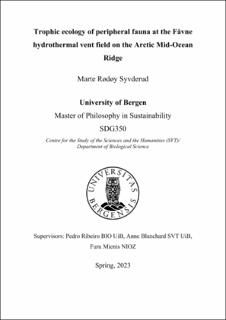| dc.description.abstract | Fåvne vent field is one of the most recently discovered vents on the Arctic Mid-Ocean Ridge (AMOR) and consists of both active and inactive vents. It was discovered in 2018, and there are only a few published papers on the area to date. Due to the increasing interest in deep-sea mining of rare earth metals and other minerals at AMOR, there is a race to reduce the knowledge gaps in vent areas to better understand how mining will affect life in the surrounding areas. This thesis aims to understand the food web structure of active hydrothermal vent´s background fauna, investigate how connected and dependent they are to the active vents, and examine how decisions are made when knowledge is lacking. To achieve this, specimens and environmental samples collected from Fåvne were tested for Carbon and Nitrogen stable isotopes to create a food web. In addition, DNA sequences were run to identify if there were any cryptic species among the data set. We collected 29 specimens divided into six groups based on morphological classification: Asconema, Demospongiae, Cladorhiza, Actiniaria, Asteroidea, and Amphipoda. The food web was created and compared to the expected trajectory of a deep-sea habitat. There was no clear indication that the background fauna had any direct connection to the active vents or that the sea floor was a part of the nutrient chain. But there was a large gap between the primary food source and the primary consumer, indicating that the food web lacks one or more trophic levels. This baseline knowledge can be useful for assessing the impact of deep-sea mining as part of a more extensive knowledge base. There will always be knowledge gaps concerning deep-sea ecology and mining hydrothermal vents, and it is, therefore, essential to enlighten and communicate these uncertainties in a transparent manner. And when making decisions, it is important to assess the situation against the best available knowledge. A good principle to use is the precautionary principle, which allows choices to be made based on the best available knowledge and the awareness that the knowledge base may be incomplete and allows for reevaluation if the situation or knowledge should change. | |
